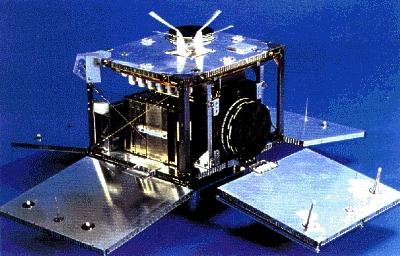Astrid (original) (raw)

Home - Search - Browse - Alphabetic Index: 0- 1- 2- 3- 4- 5- 6- 7- 8- 9
A- B- C- D- E- F- G- H- I- J- K- L- M- N- O- P- Q- R- S- T- U- V- W- X- Y- Z
Astrid

Atrid 1
Astrid 1 Satellite
Credit: via Goran Olsson
Swedish earth magnetosphere satellite. Sweden's third scientific satellite and first microsatellite.
AKA: Freja-C. Status: Operational 1995. First Launch: 1995-01-24. Last Launch: 1995-01-24. Number: 1 . Gross mass: 26 kg (57 lb). Height: 45.00 m (147.00 ft).
ASTRID carried an Energetic Neutral Atom analyzer, an Electron Spectrometer and two UV imagers for imaging the Earth's aurora. Astrid was piggyback launched with the Russian Tsikada navigation satellite and FAISAT, a small store-and-forward communications satellite. Astrid's scientific instruments went into full operation on Feb 6, after the satellite started getting eclipse periods on every orbit. During a month of operation, 20-30 hours of data were collected over 150 orbits. On March 1, a DC/DC converter for all the three instruments failed to switch on, preventing further scientific operations. However, the satellite proved to be a useful testbed in subsequent months for store-and-forward communications and for autonomous sun-pointing software algorithms.
The spacecraft was spin stabilized, controlled with magnetic torquers and a nutation damper. Spin up was accomplished with a small solid rocket thruster. A flux-gate magnetometer and solar aspect sensor provided attitude sensing. Four solar panels provided roughly 20W of power to the payload, spacecraft bus, and for charging 2 NiCd batteries. Data processing was handled by an 80C31 processor with 8MB of memory available. Downlink occurred via S-Band (2208.629 MHz) at 131 kbps or via 400.55 MHz at 8kbps. Transmitter power was 2 W. Commands were uplinked in the 449.95 MHz band at 4800 bps. Astrid was controlled from Swedish Space Corporation's ground station at ESRANGE in Kiruna.
Astrid's scientific payload was developed by the Swedish Institute of Space Physics in Kiruna. The main instrument was a neutral particle imager, or PIPPI (Prelude in Planetary Particle Imaging). The operation of PIPPI in orbit was the first time a dedicated instrument had been used to measure neutral particle flux from the ring current. An Electron Spectrometer, EMIL (Electron Measurements - In-situ and Lightweight), measured electron distribution at 62.5 ms or 125 ms resolution. Two UV imaging photometers, MIO (Miniature Imaging Optics), were mounted in the satellite spin plane. One observed Lyman alpha-emission from the Earth's geocorona, the other observed auroral emissions.
Family: Earth, Magnetosphere sat, Medium earth orbit. Country: Sweden. Launch Vehicles: R-14, Kosmos 3, Kosmos 11K65M. Launch Sites: Plesetsk, Plesetsk LC132/1. Agency: SSC. Bibliography: 2, 6.
1995 January 24 - . 03:54 GMT - . Launch Site: Plesetsk. Launch Complex: Plesetsk LC132/1. LV Family: R-14. Launch Vehicle: Kosmos 11K65M.
- Astrid - . Mass: 26 kg (57 lb). Nation: Sweden. Agency: SSC. Class: Earth. Type: Magnetosphere satellite. Spacecraft: Astrid. USAF Sat Cat: 23464 . COSPAR: 1995-002B. Apogee: 1,027 km (638 mi). Perigee: 963 km (598 mi). Inclination: 82.90 deg. Period: 105.00 min. Auroral plasma and auroral imaging..
Home - Search - Browse - Alphabetic Index: 0- 1- 2- 3- 4- 5- 6- 7- 8- 9
A- B- C- D- E- F- G- H- I- J- K- L- M- N- O- P- Q- R- S- T- U- V- W- X- Y- Z
© 1997-2019 Mark Wade - Contact
© / Conditions for Use